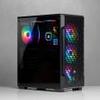Final Words & Conclusion
Final Words & Conclusion
I will summarise the 220T by dividing the conclusion into two sections, a 'Why should you buy the 220T,' and a 'Why you shouldn't.' I think you can probably all tell that I really like this case. Corsair have done a good job and despite some fairly minor annoyances, the 220T comes out of its testing looking really rather good. So, with that, on we go...
Why should you buy the Corsair 220T?
Overall, I think that Corsair have done an exceptional job here. The 220T starts off well, with pretty decent build quality. Notice the use of 'pretty decent', there. In my view, whilst solid, the build quality of the 220T doesn't quite live up the bar set by cases like Fractal's Define or Meshify series. However, as I noted in this review, the 220T comes packing some neat little extras, namely 3x fairly decent RGB fans, and an included lighting controller that can fit an additional 3 fans or devices. Without these, these would probably be a €/£/$60 case. With them included, it's fair to say you're getting a pretty decent deal in terms of 'what you get'. Add the cost of a 3 pack of RGB fans onto 60ish EUR/GBP/USD, and a lighting node controller, and we're in the 100-110 range, I would imagine. It's safe to say, therefore, that you sacrifice a bit of build quality overall for what you get in accessories. I think this is a fair trade-off, personally.
The next good point is just my personal preference and isn't objective in any way, but it is to do with looks. I think this case is good looking, and it is relatively understated with the PC powered off. However, power the build on, and the RGB is really allowed to shine. I hope this comes across in the photos reasonably well, but Corsair's funny looking front panel has the effect of very effectively diffusing the light through it. The effect, in my mind, is very nicely done.
Finally, I think this case really is quite versatile. Now, sure, you won't be able to liquid cool in it, but this size of the case - I should say - has many a use. Many of us are looking for smaller and smaller PCs that don't need us to sacrifice on the creature comforts we find with regular ATX builds. Multiple fan headers on boards, space to work in, room to add expansion cards, etc. Choose a mini ITX system for the same of form factor and, sure, it's small, but you're giving up a lot. The 220T fits underneath my desk (easily, in fact) and is still very much a mid-tower case. Now, to be clear, the 220T is by no means the first 'small' ATX mid-tower, at all. However, for me, it hits all the right spots. Size, modern features, modern looks, and so on. Want to drop your $600 worth of parts into this PC? Sure, that's kinda' what I did! R5 2600, 16GB RAM, RX 580, all for about 650 EUR/USD/GBP. There you go. Do you, however, want to slap your $1,500 rig into the 220T? Sure, go right ahead, it'll look really good.
Why shouldn't you buy the 220T?
I can really only think of... 2 things, that would stop me buying the 220T. The first is, ironically, the build quality. Much of the case's weight comes from that all-metal front panel. Once removed, the case really is fairly light. If you don't like the RGB or anything about the 220T's presentation, you can easily pick up a case like the Define C from Fractal, and get a chassis of the same/similar price, with objectively better build quality and cable management opportunities. That is a fact, and it cannot be avoided.
To my mind, however, a more serious problem is the one raised by both ourselves and the fellas over at Tweaktown. The 220T is advertised as being compatible with a wide variety of radiators. However, nowhere in the promotional material and/or tech specs for this case did I see it being mentioned that top mounting of 2+ slot (i.e. 240mm and beyond) radiators might well be impeded by either your RAM modules or (less likely) a particularly large VRM heatsink. This cannot have escaped Corsair during testing and it is also a problem I ran into on my 275R, requiring the removal of my RAM's heat spreaders to actually get the 240mm radiator to fit up top.
I didn't make a big thing of it then, assuming it to be a one-off. Now, however, it appears that it's a thing. Note that it might well have been a known issue for small(er) ATX cases before, I just haven't encountered it enough to be of note. Would it stop me buying this case? Well, no, because I don't use liquid coolers. That answer, however, is academic as I'm reviewing this case for all of you collectively. Should it, therefore, stop you buying the 220T? Well that all depends on what you want the case for. High-end build with a fat/long GPU and power-hungry overclocked CPU requiring a water cooler? Maybe look elsewhere. Not that? Yes, I think it'll do alright. Aside from this, there really is nothing else that I can mention that is negative about the 220T. With that, shall we go to our conclusion?
Conclusion
This will be short and sweet. Do I recommend the 220T to prospective builders? Yes, without a doubt. It's small, good looking, has reasonable airflow, great additional accessories, and is highly versatile. The build quality could be more solid/heavy in some areas, but I can forgive this given the overall package that you are getting for sub 90 GBP/USD. I do take issue with the radiator problem, however, and I would suggest that - going forward - the actual positioning of the radiator with regard to compatibility be paid closer attention to, so as to not potentially mislead people into thinking that a top-mounted 240-280mm radiator will fit when in reality it might not. Overall, great case. Really good job on this one, Corsair. Just maybe pay a little more heed to radiator placement in the future?
- Sign up to receive a notification when we publish a new article
- Or go back to Guru3D's front page



